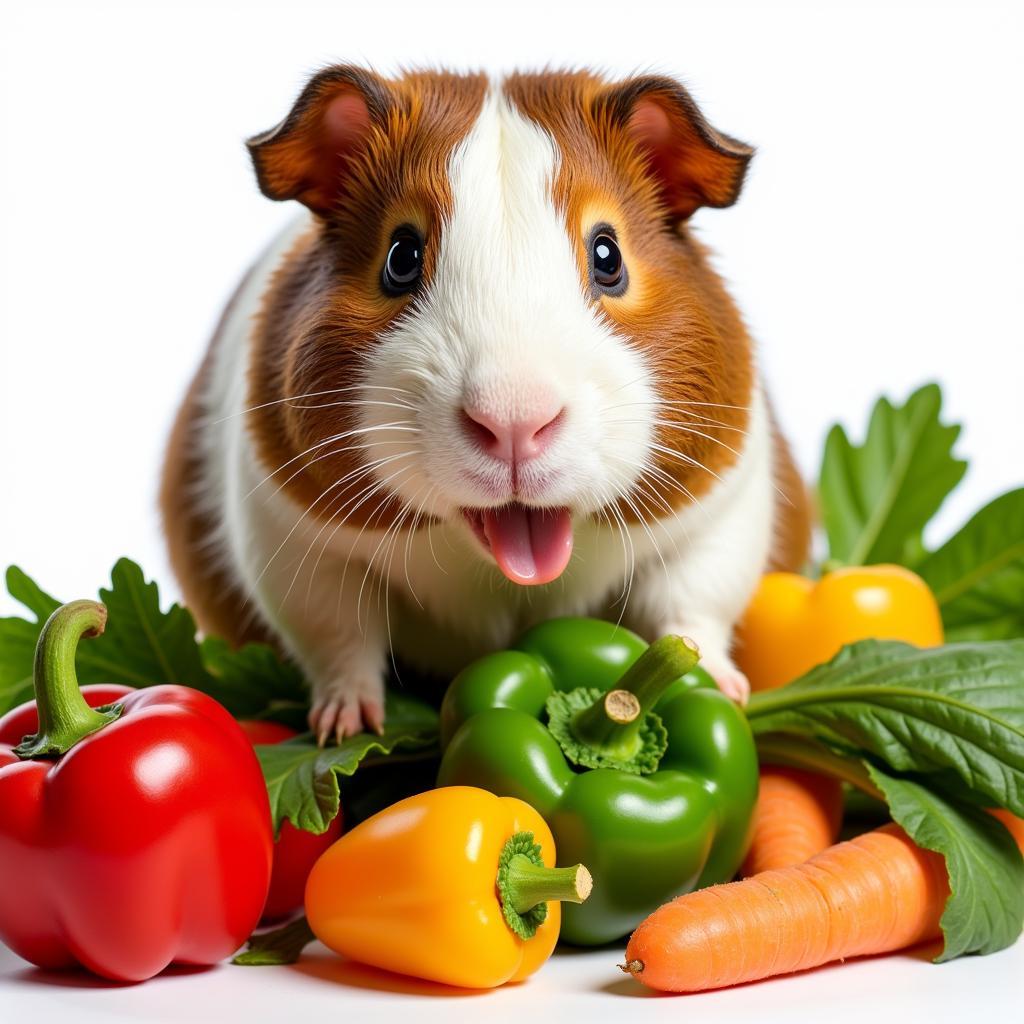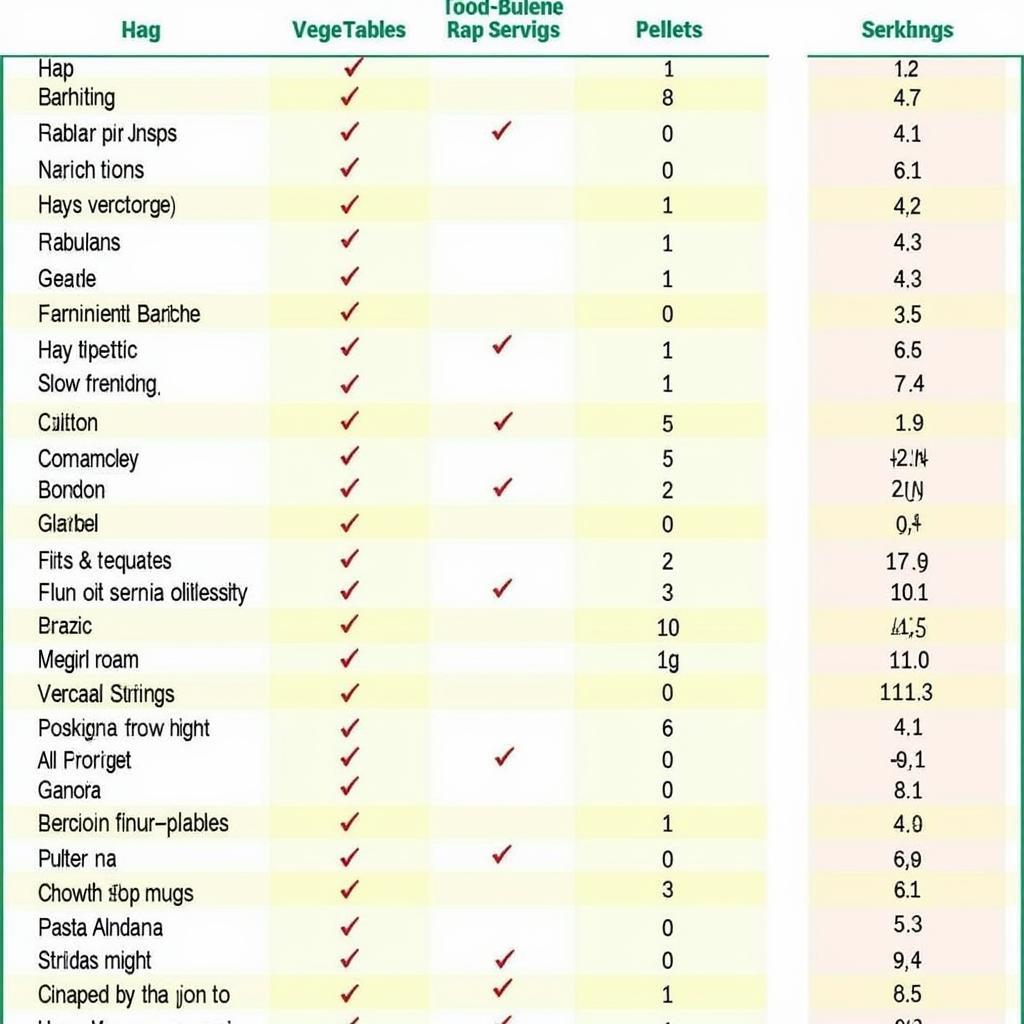Finding a reliable Guinea Pig Food Chart Pdf can feel like searching for a needle in a haystack. You want the best for your little cavy, and knowing what they can and can’t eat is crucial for their health and happiness. This guide dives deep into guinea pig nutrition, providing you with all the information you need to create a balanced and delicious diet for your furry friend.
Understanding Your Guinea Pig’s Dietary Needs
Guinea pigs, like humans, require a variety of nutrients to thrive. Their diet should consist primarily of hay, supplemented with fresh vegetables, a small amount of pellets, and of course, fresh water. Understanding the role of each component is key to ensuring your guinea pig gets everything they need.
The Importance of Hay
Hay is the cornerstone of a guinea pig’s diet. It provides essential fiber, which aids digestion and keeps their teeth healthy. Timothy hay is a popular choice, but orchard grass and meadow hay are also excellent options. Make sure your guinea pig has access to unlimited fresh hay at all times.
Vitamins and Minerals
Vitamin C is vital for guinea pigs, as they cannot produce it on their own. A deficiency can lead to scurvy, a serious health issue. Provide vitamin C-rich vegetables daily, such as bell peppers, kale, and parsley. Pellets formulated specifically for guinea pigs are also a good source of vitamin C and other essential nutrients.
Vegetables: A Colorful Addition
Fresh vegetables add variety and essential nutrients to your guinea pig’s diet. Leafy greens like romaine lettuce and spinach are good choices, as are carrots, cucumbers, and zucchini. Introduce new vegetables gradually to avoid digestive upset.
Pellets: A Supplemental Source
While hay and vegetables form the bulk of a guinea pig’s diet, pellets provide a concentrated source of vitamins and minerals. Choose high-quality pellets specifically formulated for guinea pigs, and avoid those with added sugars or artificial colors.
Creating Your Own Guinea Pig Food Chart
While a guinea pig food chart PDF can be helpful, creating your own personalized chart allows you to tailor the diet to your guinea pig’s specific needs and preferences. Consider factors like age, activity level, and any existing health conditions.
What to Include in Your Chart
Your chart should include a list of safe foods, their nutritional benefits, and recommended serving sizes. You can also include a section for foods to avoid, such as chocolate, caffeine, and avocados, which are toxic to guinea pigs.
 A Guinea Pig Munching on Fresh Vegetables
A Guinea Pig Munching on Fresh Vegetables
Tips for Creating a Balanced Diet
Variety is key to a healthy guinea pig diet. Offer a range of vegetables and hays to ensure your pet receives a balanced mix of nutrients. Monitor your guinea pig’s weight and adjust portion sizes as needed.
“A balanced diet is essential for a happy and healthy guinea pig,” says Dr. Emily Carter, DVM, a small animal veterinarian specializing in exotic pets. “Providing a variety of fresh foods, along with unlimited hay, will keep your cavy thriving.”
Common Guinea Pig Food Chart Questions
What about treats? While treats should be given sparingly, occasional small pieces of fruits like apple or strawberry can be a welcome addition.
Can guinea pigs eat nuts? Nuts should be avoided, as they are high in fat and can lead to obesity.
 Example of a Guinea Pig Food Chart
Example of a Guinea Pig Food Chart
Conclusion
Creating a balanced and nutritious diet for your guinea pig is a vital part of responsible pet ownership. While a guinea pig food chart PDF can be a starting point, understanding your guinea pig’s specific needs and building a personalized food plan is the best way to ensure their health and well-being. By following the guidelines outlined in this comprehensive guide, you can provide your furry friend with a delicious and nutritious diet that will keep them happy and hopping for years to come.
FAQ
- What kind of hay is best for guinea pigs? Timothy hay is a popular and readily available choice.
- How much vitamin C should my guinea pig get daily? Approximately 10-30 mg per day.
- Can guinea pigs eat iceberg lettuce? No, iceberg lettuce has little nutritional value and can cause digestive issues.
- What are some signs of vitamin C deficiency in guinea pigs? Lethargy, loss of appetite, and joint pain.
- How often should I clean my guinea pig’s cage? Spot cleaning should be done daily, with a full cage cleaning at least once a week.
- Can guinea pigs eat grapes? Grapes can be given as an occasional treat, but in small quantities due to their sugar content.
- How can I tell if my guinea pig is dehydrated? Signs of dehydration include sunken eyes, dry mouth, and decreased urination.
Do you have more questions regarding Guinea pig diets or other related topics? Check out our other helpful articles on the website.
Need help? Contact us! Phone: 02437655121, Email: minacones@gmail.com or visit us at 3PGH+8R9, ĐT70A, thôn Trung, Bắc Từ Liêm, Hà Nội, Việt Nam. We have a 24/7 customer service team.